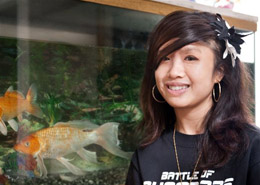
Ten years ago, Rheena Fernandez emerged from a coma after a rare disease attacked her brain. Two years ago, persistent seizures brought her back to Rady Children’s. Now in college, she hopes to work with kids.
A parent’s worst nightmare is losing a child to illness or injury. For 20-year-old Rheena Fernandez, her parents thought that nightmare was going to be a reality, not once but twice in her young life.
Ten years ago, Rheena was first hospitalized with severe abdominal pain and headaches that led to a diagnosis of hemorrhagic leukoencephalitis, inflammation of the white matter around the brain.
White matter consists of the tissue in the brain that carries messages and information between the gray matter regions of the brain. If you think of your brain as a computer network, the white matter is like the cables that ensure your computer, printer and modem can all communicate with one another.
When the white matter in the brain swells, it causes pressure that can prevent blood from flowing to the brain resulting in brain death or a persistent vegetative state.
“When Rheena was first admitted, we proceeded with the most aggressive care to insure her brain received adequate blood flow,” says Dr. Bradley Peterson, director of the Ernest Hahn Critical Care Unit at Rady Children’s Hospital–San Diego. “Even though many were skeptical that she would survive, we did not quit on her and provided aggressive life support for many weeks.”
After months of intense therapy in the Hospital, including a brain biopsy and rehabilitative care, she emerged from the coma. Rheena was subsequently discharged and went back to leading a normal teenage life. She graduated from high school, got her driver’s license and loved hanging out with friends.
“It really is remarkable that she survived that first hospitalization,” says Dr. John Bastian, director of the allergy and immunology clinic at Rady Children’s. “Most patients with this severe a condition do not survive.”
Then in June of 2007, Rheena began having hallucinations, severe headaches and high fevers. She also began having seizures.
Initially admitted to another hospital, Rheena’s parents insisted that she be transferred to Rady Children’s since she was previously treated there.
“Rheena was going downhill fast,” says Rexy Fernandez, Rheena’s mom. “Her oxygen levels were low. She was not responsive. She wouldn’t open her eyes. We knew she needed to go to Rady Children’s to have a chance.”
When she arrived at Rady Children’s, Rheena’s brain was in a state of persistent seizures. A machine was breathing for her, and her prognosis looked bleak.
Physicians familiar with Rheena’s case attempted the same treatment regiment that had saved her life a decade earlier. She showed improvement initially, but would relapse again.
“It was like a yo-yo in the beginning,” says Rexy. “She would start to get better, only to slip back and get worse again. It was terrible.”
Sensing that Rheena’s prognosis was not going to improve unless something changed, physicians from Rady Children’s Pediatric Intensive Care Unit (PICU), Allergy and Immunology Division and Rheumatology Division all banded together to come up with an innovative therapy plan.
Dr. Seema Aceves and Dr. Hal Hoffman, both of Rady Children’s Allergy and Immunology Division, have done extensive research on inflammation. After reviewing the results from Rheena’s brain biopsy 10 years earlier and her current inflammation levels, they recommended trying a drug called Anakinra, which is used primarily to treat rheumatoid arthritis.
Dr. Robert Sheets, a pediatric rheumatologist at Rady Children’s, helped coordinate the proper dosing of what turned out to be the life-saving medication.
It didn’t take too long for Rheena to show signs of improvement once the medication was started. However, once the inflammation in Rheena’s brain was under control, the real work began for Rheena and her family. She was unable to walk, talk or eat on her own.
“She was like a baby again,” says Rexy. “She couldn’t even lift a finger on her own at first. But she is a fighter and eventually she’s learned to do things for herself again.”
After six months in the Hospital, Rheena was discharged. She is still on medication to control a seizure disorder, but is getting better with time. She recently began taking classes at Mt. Jacinto College and hopes to work with children some day.
In addition to determining the right combination of medications to help heal Rheena’s brain, the physician collaboration led to the discovery of a novel gene mutation that may someday help to explain what caused Rheena’s hemorrhagic leukoencephalitis.
Rheena has a deficiency in the complement factor I, which controls the complement system, a series of proteins in the blood that usually kill bacteria. However if there is a deficiency in Factor I, then the body’s immune system can turn on itself and destroy human cells.
In Rheena’s case, Bastian said they think her brain may have suffered some type of injury that activated the complement system, and without Factor I her brain couldn’t control it, resulting in severe inflammation. Unfortunately, her condition is so rare, there may never be a definitive answer as to why this occurred.
While there are still many questions surrounding Rheena’s illness and prognosis, one thing is certain. She is a remarkable young lady, who, according to doctors and her family, is a walking, talking miracle.
The San-Diego Union-Tribune Kids’ NewsDay, October 2009